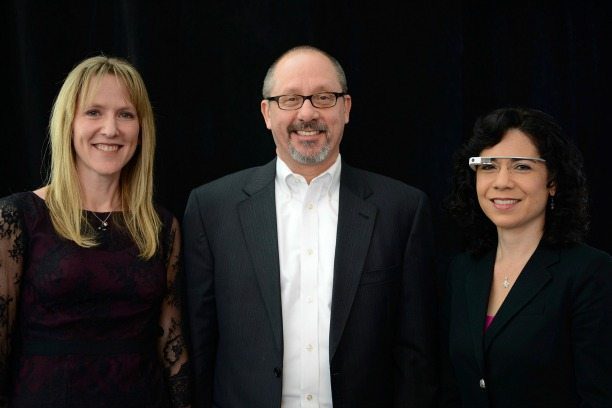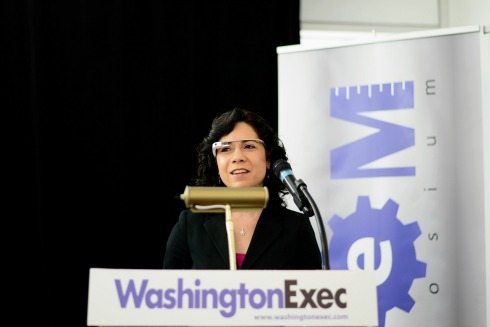
The jobs of tomorrow have not even been invented yet.
So more important than eyeing a specific career, the first two presenters at the inaugural STEM Symposium held this past weekend at the Nysmith School for the Gifted in Herndon, Va., encouraged young students to focus on learning the thinking and mindset around STEM (science, technology, engineering and mathematics) and to be open to a variety of professional positions that emerge from that knowledge.
The symposium, put together by WashingtonExec and its STEM Council, brought together 1,500-plus parents, students, teachers and business professionals in related industries to talk about the importance of teaching children science and math disciplines and to strategize about how to help them enter these growing fields.
The all-day symposium leads up to the third annual USA Science and Engineering Festival, the country’s only national science fair, on April 26 & 27 at the Walter E. Convention Center in Washington, D.C.
During the opening session Michele Weslander Quaid and Ann Barron-DiCamillo with leadership roles at Google and the U.S. Department of Homeland Security, respectively, shared insights about their paths to success. The panel topic, Industry & Government Perspectives: Workforce Needs and Solutions, was moderated by the STEM Symposium’s Co-Chairman Rob Zitz, Senior Vice President of the National Security Sector at Leidos.
Barron-DiCamillo and the U.S. Computer Emergency Readiness Team (U.S. CERT) is now at the forefront of trying to protect the country against cyber threats. She serves as the Director of U.S. CERT, within the Department of Homeland Security. Growing up in the Midwest, Barron-DiCamillo said she was interested in Atari and was a computer nerd, but also spent a great amount of time running around outside. As a child, she never thought about working in cybersecurity but others directed her to that field — and she’s thankful they did.
“The most exciting thing for cybersecurity professionals in our field is getting to work on new puzzles every day,” she explained. “It may be frustrating but it is never boring! …The core idea is to constantly be questioning and to use sound reason in order to reach your decision.”
Barron-DiCamillo’s message was that science and art are not mutually independent. She encouraged students to pursue a wealth of interests and to branch out beyond traditional STEM coursework as experience in problem solving and analysis can be adapted from other fields of study. Cybersecurity in particular is full of professionals with interdisciplinary backgrounds.
“My philosophy about STEM is to add an A for ‘art’ to create STEAM,” she explained. “My niece is studying Russian as a minor to her engineering computer science degree. Just because you’re pursuing a career in engineering doesn’t mean you can’t pursue the arts as well, as part of a holistic approach to STEM.”

Similarly, Weslander Quaid, Public Sector Chief Technology Officer and Innovation Evangelist at Google, emphasized that students need to discover what interests and excites them and then pursue purposeful possibilities around that passion. In school, she enjoyed and excelled in a broad range of subjects to include theater, music, history and creative writing, as well as STEM. Weslander Quaid was fascinated with space and dreamed of traveling into space someday, and, per the encouragement of her high school physics teacher, she decided to pursue a technical track and entered college as a physics major. At her university, she was exposed to the field of engineering and added a second major in engineering science, recognizing the value of the practical application of science through engineering.
Weslander Quaid’s career has been chronicled as a continuous state of discovery, bold pioneering and challenging the status quo, leading change, and innovative technology application to solve difficult problems.
“The skills you learn in STEM — analysis, critical thinking, problem solving, testing out hypotheses, decision making — will help you later in life no matter what you do,” Weslander Quaid said. STEM can be challenging, and the persistence students develop by sticking with a hard problem until they solve it will benefit them in life as they face many other challenges. “STEM doesn’t have to come easy to you in order for you to be successful in this field,” she said. Good communications skills are important. Being able to convey complex technical concepts in a way that is easy for a non-technical audience to understand is a major asset. Adaptability is also key. “Students graduating today will have jobs in fields that have not been invented yet, and future technology breakthroughs will lead to new careers. That’s why the life skills you learn through STEM are important as you follow your passion and find your purpose.”
“Google looks for tech savvy people with leadership skills, who challenge the process and don’t want to accept the world how it is today, have a bias for action and a healthy disregard for the impossible.”
Ed Swallow, vice president of Business Development for the Federal and Defense Technologies division of Northrop Grumman’s Information Systems Sector, in introducing the event, told attendees that the STEM Council didn’t want to sit around and admire the problem of students not entering STEM fields but to “get something done.”
Throughout the day’s panels, speakers often referenced inflection points that caused them to pursue work in STEM as a means of inspiring the parents and children. For Swallow, that trigger was in fourth grade.
“I got to go to my first science fair,” he said. “My school didn’t have one, so I went to a fair in a nearby school district…That became the event that made me think, ‘I want a career in math or science.’”
The Nysmith School, where the event took place, just celebrated its 30th year. At that time the school began implementing science as a daily part of the curriculum. Instruction has only become more focused on science and technology-related subjects since then. Ken Nysmith, headmaster of the school, spoke of it being a new day when it comes to educating youth in the United States and the need to push STEM.
“We’re at the beginning of a new revolution,” he said. “We’re talking about the future.”
The event’s presenting sponsor was Leidos and founding sponsor was Northrop Grumman Corporation.
Photos by Abigail Gorden.

